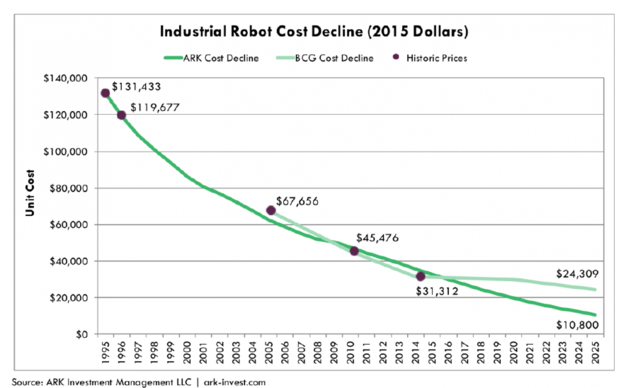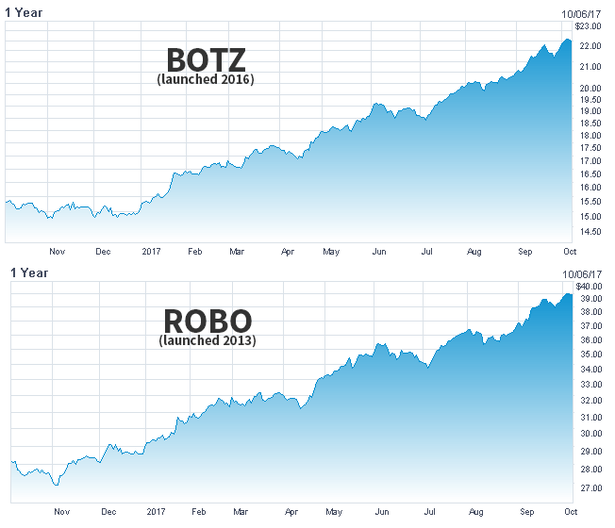
Looking to Make a Fortune Investing in Robotics?
For 2018, big winners rare while broad, quick growth settles in to stay awhile
Backstory to investing
If you’ve been scouring the markets looking to spy an IPO in robotics akin to Intuitive Surgical’s (NASDAQ:ISRG) launch at $9 bucks a share that now trades for over a grand, forget it. That was back in 2000 when the millennium was new and fresh, when a robot’s primary occupation was making autos and trucks, when anything and everything seemed possible.
Here in 2017, with nearly two decades of grumbling over the whereabouts of another Intuitive-type champion that could quickly make a boatload of money, many have given up in frustration but still keep half an eye peeled hoping to spot another winner.
Maybe soon, maybe next quarter, maybe next year—when? Someone’s making money on robots, why can’t it be spread around more, is a frequent lament. Waiting for another killing in the market has been a bit like waiting for Godot.
To the chagrin of many, we now know that robotics is high tech, but it isn’t IT. It’s not dump the cash in for fast growth and quick returns; robotics is hardware, software, mechatronics, and systems engineering all rolled up into incredibly complex machines that take more time to build and perfect than investors are willing to give them.
Well, 2018 may well be the year Godot finally arrives for an extended stay. Robotics, already experiencing an investment-friendly binge, is readying for much more, which should be good news for those who have been saving up for the big event.
Three significant, converging factors have created this inviting investment climate:
1. Robot technology has advanced such that robots are now skilled enough to work in places other than auto plants. In addition to manufacturing, these technological advances are disrupting every industry and vertical from agriculture to healthcare, pharmaceuticals, energy, and logistics, security, and transportation, among the many others.
Machine vision, GPUs, laser sensors, haptics, edge computing, the Cloud, Big Data, predictive analytics…and the latest guardian of the galaxy, AI (artificial intelligence) in all its forms and abilities, are the tech advances driving deployments of industrial robots…and cobots.
Wyatt Newman, robotics researcher from Case Western, touts AI as the sweet spot of automation. “We’re seeing a dramatic change in AI capability, he says. “When you give robots better brains, what you’re doing is allowing your AI to have physical effects on the world, whether that’s transporting you from A to B, or fulfillment, or it’s doing farming, manufacturing, security, the brain and the machine are making the difference. That revolution is really spurring things on.”
2. Significantly, more robots doing more things in more places has meant that their popularity and numbers have increased such that there are way more of them.Sales are fantastic beams the International Federation of Robotics in one communique after another almost daily. Such a profusion of the machines has driven down prices.
A PwC analysis found that “offshoring jobs could save a firm approximately 65% on labor costs while replacing workers with robots can achieve an estimated 90% in savings,” which is sure to drive the sale of robots and automation machinery ever higher.
ARK Investment Management produced the chart below: Industrial Robot Cost Decline. And here’s their take on that decline: “According to ARK’s research, industrial robot costs will drop by roughly 65%, to levels much lower than most analysts now anticipate, by 2025. Combined with advances in machine learning and computer vision, this drop in costs should cause an inflection point in the demand for robots as they infiltrate new industries with more provocative use cases.”

3. Industrial robots are high-quality, productive workers; humans can’t match their output. Because of these steel-collar workers and their peerless output—around the clock if necessary!—productivity gets a boast. Factory owners like the increase in productivity, low price and ROI of these workers, so they are buying ever more.
Such mass productivity affects GDP. Georg Graetz of Uppsala University and Guy Michaels of the London School of Economics in their Robots at Work “found that, on average…the increasing use of industrial robots over the time period raised the annual growth of GDP by 0.37%. They compared this substantial growth to the boosts in productivity that occurred at the turn of the 20th century from steam technology.” The comparison was near identical.
What’s not to like? All of this new technology, new applications, more deployments, and lower prices have raised up a virtuous circle benefitting everyone. Best of all, now that this troika has converged and is in place, look for rapid innovation to take over and to accelerate further advances.
The net-net is that the robotics ecosystem is burgeoning and the investment opportunities are multiplying rapidly across a broad front.
Will an Intuitive-like, dream-buy arise? Probably not. These days, great robotics tech doesn’t last too long before it is scouted out and scooped up by a deep-pocketed tech giant. Universal Robots was one that would have made for a powerfully rich IPO but was acquired by Teradyne for $285 million. Look for more of the latter than the former as convergence intensifies.
Manufacturing is on the leading edge of this convergence. Our multi-part seriesWelcome to Intelligent Manufacturing 2018 takes a deep dive into what’s ahead for both robots, robot parts, and automation.
In the meantime, the half eye peeled for a robotics winner is suddenly bulging in glee at what robotics is now offering up.
So where is the investment money going?
ETFs?
Knowledge is power. The quickest way to get investment savvy is to acquire a good understanding of who the players are in robotics, robot parts, and factory automation.
Don’t bother to hunt and peck around trying to find them, let the pros show you. The lists of companies indexed in ETFs (Exchange-Traded Funds) have all of the players that most anyone will need to know about in order to get a good purview of global robotics.
Robotics ETFs are newbies, only on the scene since 2013, when the first of them arrived: Robo Global Robotics & Automation Index ETF (ROBO). As such, there’s not a lot of performance history here. However, the last four years were robotics coming out years, so not a lot of historical info is needed.
Here are the five ETFs:
Global X Robotics & Artificial Intelligence ETF (BOTZ)
Robo Global Robotics & Automation ETF (ROBO )
iShares Automation & Robotics UCITS ETF (RBOT:London)
Pictet – Robotics R EUR (PRB1:SW)
Candriam Robotics and Innovative Technology (new launch March 2017)
From the companies indexed in these five ETFs is where to acquire a data set upon which to do some initial analysis; compare who is on which index and why.
Morningstar’s Karen Kwok did it for us in her How to Profit from the Rise of Robotics. “Flows into robotics ETFs and actively managed open-end funds,” she writes, “have accelerated significantly over the last 12 months, from an estimated $5 billion to $9 billion…data compiled by Morningstar Direct showed that February recorded the largest monthly inflows of robotics ETFs ever with $162 million. Robotics ETFs saw $112 million inflows in March too.
In the four-month period December to March, “assets under management for these four ETFs grew from $415 million in December to $1.1 billion in March.”
Since March, according to FactSet, Robo Global fund’s assets under management have more than doubled to $670 million from $286 million.
Of the two in Europe, “Pictet soft-closed its Robotics fund after hitting $3.5 billion in assets in less than two years since launch. The decision to limit new subscriptions into this robotics fund showed the popularity of robotics investment.”
In the same month, another asset manager “Candriam Investors launched a thematic fund focused on developments in robotics and artificial intelligence.” Ah, ‘bout time, AI wiggles its way into the world of robotics ETFs.
This chart readily shows the remarkable ascent of ROBO and BOTZ since last December (similar trajectories although ROBO has four years on BOTZ). Quite simply, 2017 was a breakout year for robotics regardless of the ETF’s size or maturity. The breakout was broad and rapid…and will probably continue that way into 2018.
See related:We’ve Got Liftoff…Finally!

Equities
Getting the lay of the land and its players from ETFs is good as base knowledge in considering shares. With robotics it can be confusing distinguishing between the value of pure-play robotics manufacturers like KUKA as opposed to ABB where robotics is part of a lager enterprise of products.
Barron’s sees robotics stocks being attractive for long-term investors: “KUKA (KU2.Germany), up 9% since March; Yaskawa Electric (6506.Japan), up 11%; Rockwell Automation (ROK), up 7%; and Alphabet (GOOGL), up 13%.”
In fact, the Oct 6 Nikkei reported that Yaskawa’s F3/18 OP will likely top guidance by $65 million and come in around $471 million. According to the article, servo motors for semiconductor production equipment and industrial robots are set to grow on the tailwind of increasing demand in China, thus topping the company’s plan.
See related: Robot Parts: Critical Importance Amid Explosive Growth
Jeff Reeves, writing in MarketWatch, reckons Siemens as a good diversified play on the robot revolution: Siemens (AG SIEGY). “Siemens has its fingers in many pies, from energy and power transmission to health care, but is also a leader in automation solutions. While there are many different elements that power this stock, it’s important to note the Digital Factory division is the most profitable with a margin range of 14% to 20%… with a $120 billion market capitalization, 2.8% dividend and truly global customer base, Siemens offers a nice lower-risk alternative for those looking to dabble in automation.”
See related: Siemens Encamps Global Robot Research HQ in China. Manufacturing gets an upgrade as robots, automation and manufacturing converge and merge.
Things change
Credit Suisse put it well in an article Invest in the Future: Why Robots are Exciting Investments. “It is not just robots that have changed. Our perception of automation is also different now.” Indeed.
Our perception on investments may also be changing. Investing in robotics now means hardware and software and much more. Who would have thought just a few years ago that AI would be an investible solution for making dumb robots not so dumb anymore?
